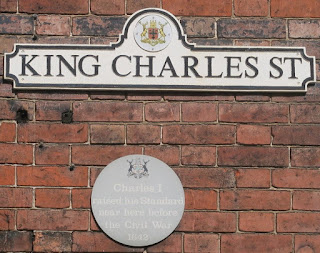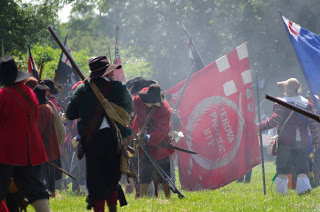Houses of Interest: Nottinghamshire
The ECWtravelogue has finally plucked up the courage to cross the border into neighbouring Nottinghamshire.
Nottingham and Nottinghamshire were an integral part of King Charles's corridor of power that stretched from Oxford to York. Having such a strategic position, it is fair to say that the County of Nottinghamshire had a significant part to play in the First Civil War.
First let's look at Nottingham: the Royal Standard was raised in August 1642 near Nottingham Castle symbolically signalling the start of the War (even though the fighting had started over a month earlier).
Newark had such a pivotal role that it gets it's own separate entries: the ECWtravelogue has visited a number of times, here's the most recent visit to the National Civil War Centre and this post looks at the town, it's Civil War trail and the Queens Sconce
Southwell is most famous for being the birthplace of the Bramley apple, but it also had a somewhat significant role to play in the events of the seventeenth century.
Charles I spent his last night as a free man at the Saracen's Head pub (then called the King's Head), before handing himself in to the Scottish Commissioners at Southwell Palace.
The Palace had been used by the Covenanter army as a barracks and headquarters, it would later be used as stabling for the New Model Army, before it fell into disrepair and ruin. Inside the palace is a very imposing portrait of Charles.
Saracens Head, Market Place, Southwell NG25 0HE
Southwell Minster & Palace, Church Street, Southwell NG25 0HD
Nottingham and Nottinghamshire were an integral part of King Charles's corridor of power that stretched from Oxford to York. Having such a strategic position, it is fair to say that the County of Nottinghamshire had a significant part to play in the First Civil War.
First let's look at Nottingham: the Royal Standard was raised in August 1642 near Nottingham Castle symbolically signalling the start of the War (even though the fighting had started over a month earlier).
 |
Plaque commemorating the raising of the Royal Standard, corner of Standard Hill/King Charles Street |
There is another marker, set into the road at the junction of Standard Hill and King Charles Street. This used to be located on the exact site of the raising of the Royal Standard. Please don't get run over when trying to find it. (If you have found the plaque, look in the road at the junction.)
Nottingham Castle was the site of a number of smaller actions during the First Civil War, eventually falling into Parliamentarian hands. One time prison to Sir Marmaduke Langdale, the castle would be slighted to prevent it's use as a military fortification. Not much of the original castle remains, apart from some foundations, sections of wall and the tunnels. The Castle recently had a major refurbishment, reopening briefly before the operating company went bust. It remained closed for quite sometime and has just reopened (July 2023).
St Nicholas Church dates from 1678, but is built upon the site of a much older church. When Colonel Hutchinson garrisoned and fortified the Castle for Parliament, Royalists took up position in St Nic's. They positioned an artillery piece in the tower where they could bombard the Castle. This bombardment was so good that Colonel Hutchinson sent men to take the church and, once taken, they levelled the site so it could no longer be used as an offensive site against the Castle.
At various times during the First Civil War Ye Olde Salutation Inn was home to recruiting offices for both Parliament and the King (although I'd probably wager not at the same time).
Southwell is most famous for being the birthplace of the Bramley apple, but it also had a somewhat significant role to play in the events of the seventeenth century.
Charles was employing a French diplomat, Montreuil, resident at ‘The Saracens Head’, to negotiate with the Scots based at Kelham. On 26th April Montreuil sent an encouraging message to Charles and consequently his preferred option, after he had successfully slipped out of Oxford, was to make for Southwell, meet up with Montreuil at ‘The Saracen’s Head’ and do a deal with the Scots, who he expected would be more reasonable than the Parliamentarian Army. As the journey was expected to be very dangerous Charles went in disguise, his beard was cut off and he dressed as a clergyman. \he assumed the role of tutor to his loyal attendant, Michael Hudson. He also took with him his servant, John Ashburnam. The three escapees reached Stamford late on May 3rd. The following night, at 11.00pm they set out for Southwell, travelling by night to avoid capture.
The Palace had been used by the Covenanter army as a barracks and headquarters, it would later be used as stabling for the New Model Army, before it fell into disrepair and ruin. Inside the palace is a very imposing portrait of Charles.
Southwell Minster is a rather imposing medieval church famous for the intricate stone carvings of leaves in the Chapter House: some of the leaves are believed to bear the marks of sword blows from when soldiers were billeted in the church.
Also inside is Charles I's coat of arms.
St Luke's, Hickling was at some point the centre of a skirmish. The 14th Century Church door bears the marks of musket balls and firing loopholes - all of which have since been repaired; the repairs are visible upon close inspection.
Attenborough, located between Beeston and Long Eaton was the birthplace of Henry Ireton (Cromwell's son-in-law, amongst other things). A plaque located on the boundary wall of 15 Church Lane records his birth. Follow the path/road along side the St Mary's Church towards Attenborough Nature Reserve.
St Margaret's, Owthorpe, has a memorial to regecide Colonel John Hutchinson, and his wife Lucy. The church is quite tricky to find, followthe appropriately named Village Street into Owthorpe and park as close as you can to the village hall (the long low clapboard building on your right), please be careful not to block the streeet or resident's access. Take the path to the church by the village hall. The church is open most weekdays and Sundays.
 |
| Wiverton Hall |
Wiverton Hall, was part of the outlying defences of Newark. Garrisoned by Lord Chaworth, defensive earthworks were dug around the approaches to the house, including gun batteries to the south. Queen Henrietta Maria would sleep here on route to Newark, as would Charles's nephews Rupert and Maurice. The house would see some skirmishing before surrendering in November 1645 to Sir Sydenham Poyntz without a fight. Wiverton would be pretty much destroyed when it was sleighted, the current house is mostly Victorian. The house now provides holiday cottage lets, and has a café/restaurant open to the public.
 |
| The Priory Church, Thurgaton |
The Priory Church of St Peter, Thurgaton was also part of Newark's outer defences. Garrisoned by Sir Roger Cooper with 40 men, they would be taken by a Parliamentarian force led by Colonel Thornhaugh in December 1644.
Norwell House, was a moated manor house, located behind St Laurence's Church in Norwell. The house is long since gone, but the ditch of the moat can still be clearly seen to the south of the graveyard. Another of Newark's outer defences, the house fell to the Scots in 1645.
 |
| Felley Priory |
Felley Priory was the home of the regecide Gilbert Millington; seized, plundered, and garrisoned for the King during the wars. Gilbert was one of the few regecides to avoid the gallows, spending his last days imprisoned in the Channel Isles. Felley Priory is a private house, but the gardens are open to the public.
Postcodes for SatNavs
Nottingham Castle NG1 6EL
Standard Hill NG1 6GB
St Nicholas Church Maid Marian Way, NG1 6AE
Ye Olde Salutation Inn, Hounds Gate NG1 7AA
Saracens Head, Market Place, Southwell NG25 0HE
Southwell Minster & Palace, Church Street, Southwell NG25 0HD
St Luke's, Hickling LE14 3AH
Ireton's birthplace, 15 Church Ln, Attenborough NG9 6AS
St Margaret's Church, Owthorpe NG12 3GA
Wiverton Hall, Tithby NG13 8GU
Thurgaton Priory Church, Priory Rd, Thurgarton NG14 7GX
St Laurence's Church, Norwell NG23 6JN
Felley Priory, Underwood NG16 5FJ
If you are going all that way it would seem pertinent to mention that Nottingham is the centre of the gaming universe. It would be churlish not to take advantage of saving postal charges... Some ECW gaming detours would include:-
Caliver Books, 40a Percy Street, Eastwood NG16 3EP
Foundry Miniatures, Church Lane, East Stoke NG23 5QF
Warlord Games, Lenton Boulevard, NG1 2BD
If you enjoyed reading this, or any of the other posts, please consider supporting the blog.
Thanks.

















.jfif)






Comments
Post a Comment